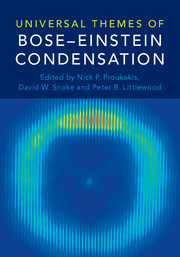Book contents
- Frontmatter
- Contents
- Foreword
- Preface
- Part I Introduction
- Part II General Topics
- Part III Condensates in Atomic Physics
- Part IV Condensates in Condensed Matter Physics
- Part V Condensates in Astrophysics and Cosmology
- Editorial Notes
- 29 Bose-Einstein Condensates in Neutron Stars
- 30 A Simulated Cosmological Metric: The Superfluid 3He Condensate
- 31 Cosmic Axion Bose-Einstein Condensation
- 32 Graviton BECs: A New Approach to Quantum Gravity
- Universal Bose-Einstein Condensation Workshop
- Contributors
- Index
- References
32 - Graviton BECs: A New Approach to Quantum Gravity
from Part V - Condensates in Astrophysics and Cosmology
Published online by Cambridge University Press: 18 May 2017
- Frontmatter
- Contents
- Foreword
- Preface
- Part I Introduction
- Part II General Topics
- Part III Condensates in Atomic Physics
- Part IV Condensates in Condensed Matter Physics
- Part V Condensates in Astrophysics and Cosmology
- Editorial Notes
- 29 Bose-Einstein Condensates in Neutron Stars
- 30 A Simulated Cosmological Metric: The Superfluid 3He Condensate
- 31 Cosmic Axion Bose-Einstein Condensation
- 32 Graviton BECs: A New Approach to Quantum Gravity
- Universal Bose-Einstein Condensation Workshop
- Contributors
- Index
- References
Summary
We outline an alternative view to quantum gravity, based on the idea that a black hole can be understood as a Bose-Einstein condensate of gravitons (quanta of gravitational energy) at the critical point of the quantum phase transition, with black hole radiation and evaporation being a manifestation of how the graviton many-body system maintains itself at criticality. Within this approach, the de Sitter invariance is quantum mechanically broken as a (1/N) effect, where N is the number of gravitons.
Introduction
Although classical General Relativity (GR) has had enormously interesting experimental predictions, going from the deflection of light to the expansion of the universe, we are still missing an efficient way to consume the marriage between GR and quantum mechanics.
We can easily identify the two main reasons that make this desired marriage extremely difficult. Quantum mechanics, as well as Quantum Field Theory (QFT), is based on notions such as particle and interaction that are defined relative to an absolute space-time. They can be extended to curved backgrounds, but when the geometry starts to affect concepts such as global time, paradoxes unavoidably appear. Moreover, the main message of GR, namely that geometry itself is a dynamical notion, creates its own set of conceptual problems. Should we think of geometry as on an equal footing as we think of other fields such as Yang Mills that we quantize on a privileged absolute Minkowski space-time? And, if that is the right way to proceed, how should we deal with the problems of renormalizability and unitarity that this naive approach immediately creates?
As it is well known the root of these perturbative problems lies in the dimensions of the coupling (the Newton constant) defining the strength of the gravitational interaction. In Wilsonian terminology, the gravitational interaction is defined by an irrelevant operator that flows nicely into the infrared (IR) but goes out of control in the ultraviolet (UV) whenever we go beyond the Planck scale, a length scale that acquires the Wilsonian meaning of a natural cutoff.
- Type
- Chapter
- Information
- Universal Themes of Bose-Einstein Condensation , pp. 620 - 634Publisher: Cambridge University PressPrint publication year: 2017

